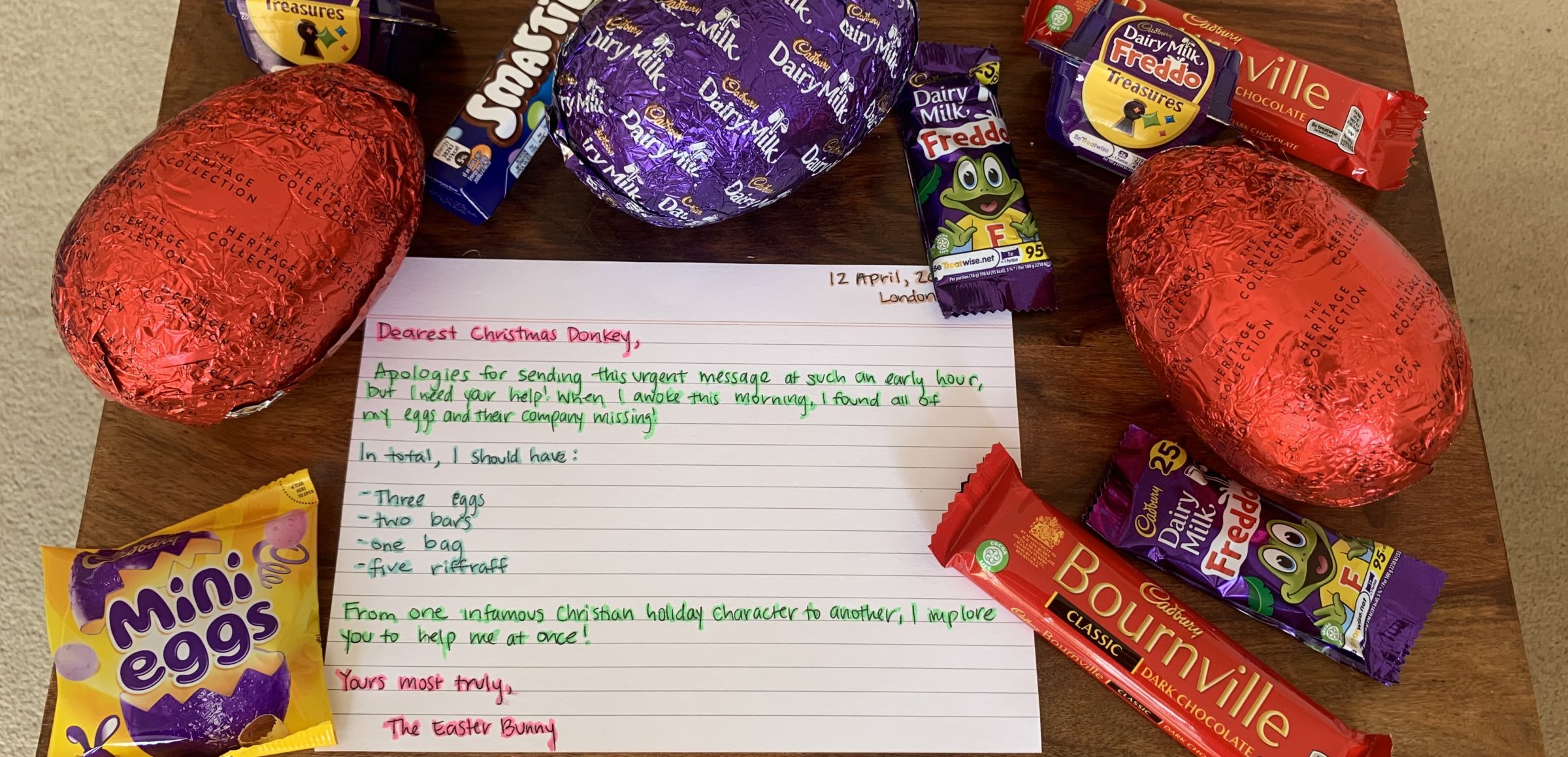We’re not much of a movie-watching household, whether self-isolating or otherwise. So it says something about the depth of Randi’s disinclination to continue watching the second of BBC Four’s back-to-back Top of the Pops episodes from the month I was born (despite featuring this engaging 1989 remix of Pop Musik) that she brightly suggested we watch a film instead, and I can therefore thank Robin Scott and his suit with “thousands of pounds worth of CDs” for the chance to finally rewatch The Usual Suspects. Note: if you don’t want spoilers for a film which came out 25 years ago, skip the next two paragraphs.
I can’t remember how old I was when I first watched The Usual Suspects, but I know that Daryl and Ermila were staying overnight with my parents and somehow we all ended up watching a VHS recording from Channel 4 with a couple of minutes missing from the middle which had accidentally been taped over with something else. (If you ever need to date someone, check whether that last sentence provokes bafflement or fond childhood nostalgia. Or, in a decade or so, sheer disbelief that friends ever visited each other in person.)
Anyway, like everyone else I thought the ending was cool and mindblowing and everything, but also I was tired and went straight to bed and it was only in the morning with Daryl that I discovered I had formed a completely wrong interpretation of what had actually happened. In my head, Inspector Kujan realises that all of the clues had been around him the whole time: Verbal’s story is all true, except for the fact that he’s also Keyser Söze, and it’s only an untidy office which saves him from getting caught. Daryl convinced me I was wrong – that the vast bulk of the film is all fabrication – and of course this makes much more sense given that the ‘clues’ in the office include the underside of a coffee mug and a manufacturer of office equipment. But it was enjoyable to go back and realise that my initial childhood interpretation hadn’t been totally crazy… after all, something had to have happened to place all the characters there in the first place. In truth, it doesn’t make a whole lot of sense either way, but it was good to get some closure on this mid-90s mystery.
This rare film screening kicked off a four-day Easter weekend which, despite being homebound, still managed to feel rather special and lovely. The highlight was waking up on Easter Sunday to find that Randi had hidden an impressive stash of chocolate around the flat to find, followed by a delicious brunch. We also did battle with two wasps and a giant bee (humans 2, insects 0), finally finished Season 4 of The West Wing, caught up with Robert/Bernie/Willow on a walk and played a gender-stratified game of Codenames with Catherine, AJ, Christian and Erika.
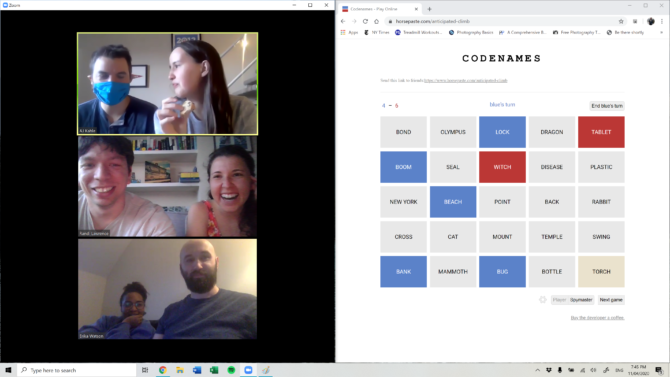
But the real point of this post, and to commemorate that next week is my one-year anniversary of moving back to London, is to overshare some graphs! Specifically, graphs like this:
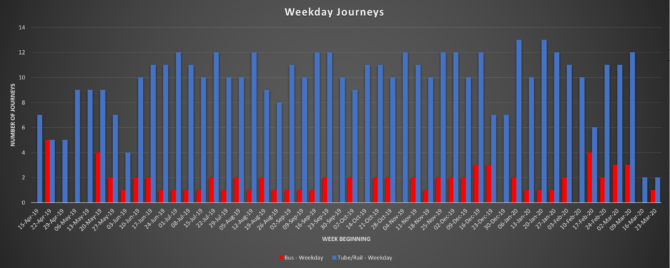
Yes, as you can see, the startling underlying conclusion from a year’s worth of my TfL travel history is that between June 2019 and March 2020 I used to commute to work. But more than just commuting, though, because the minimum Mon-Fri there-and-back commute would only require 10 train journeys, yet most weeks registered more. Very good, very social.
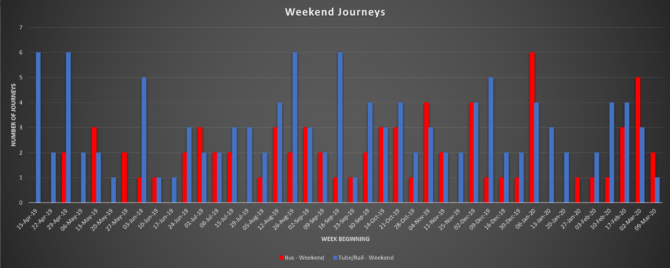
Weekends were a lot more varied, obviously, and a lot more bus-heavy. Note that none of this includes non-Oyster/contactless journeys, so forays to Hope / Stockport / St. Albans don’t count.
But the real purpose of these graphs is to celebrate Brixton station. In 2019, when TfL made yet-another-attempt to take over the forlorn rail franchises of South London, they said this about Brixton specifically:
Each day 33 double-deck bus loads of Londoners living within a 10 minute walk of West Norwood station use a bus to access Brixton Tube station instead of using their local rail service.
Strategic Case for Metroisation in south and south east London, TfL
Well, I am one of these Brixton-groupees. Look!

Brixton isn’t just my most-frequent starting station, it’s the clear soaraway winner. There’s no flattening that curve – a combination of a daily commute and the starting point for many weekend journeys too. Conversely, it’s only my third most popular exit station, because frequency and reliability don’t matter so much when you’re coming home.
And from my top 10 most popular bus routes from the past year, the top 5 all go via Brixton too:
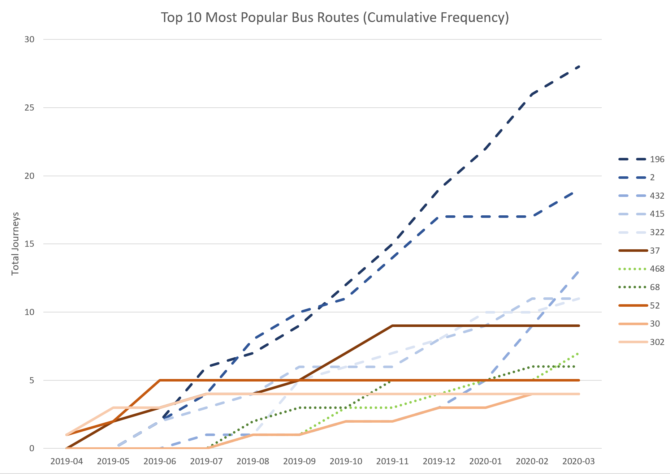
Some people long to work from home forever, but I can’t wait to get back to the warm embrace of Brixton and its many buses.
